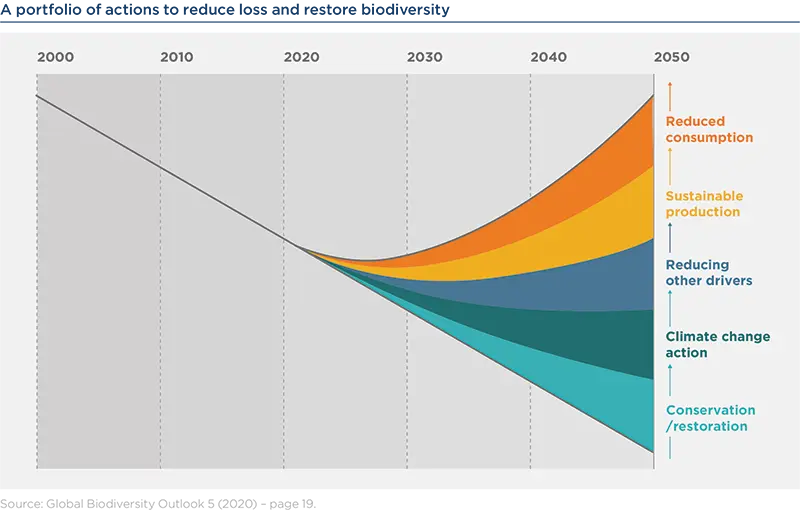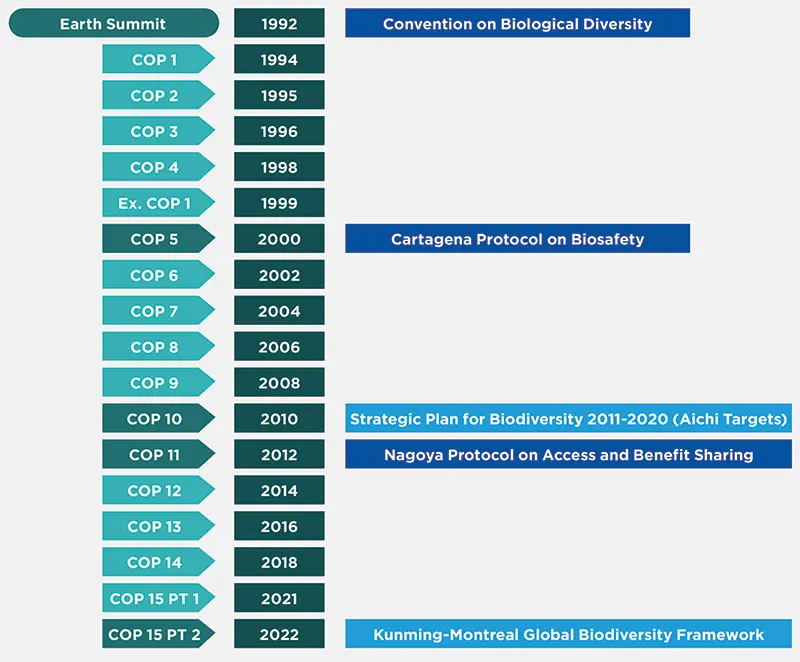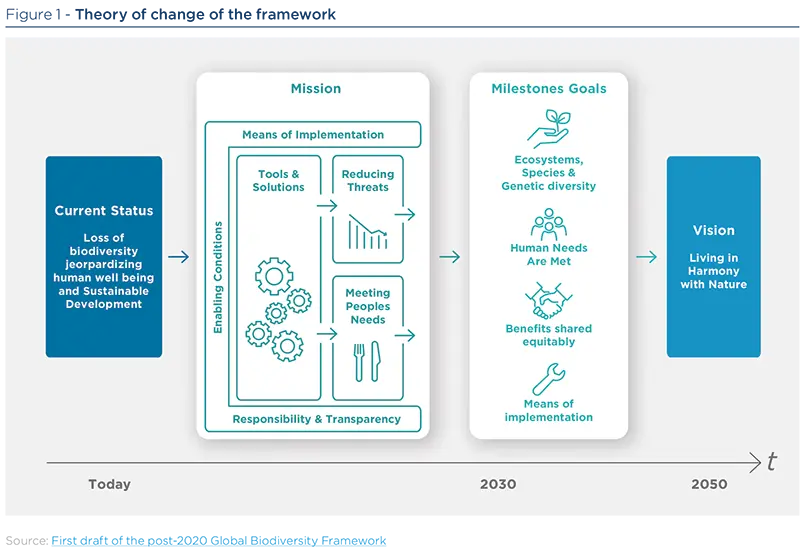Summary
Key Takeaways
Introduction
From December 7th to 19th, 2022, the second part of the 15th Conference of the Parties to the Convention on Biological Diversity (COP15) was held in Montreal, Canada. Whereas COP15 was initially supposed to take place in October 2020 in Kunming, China, it was postponed four times due to COVID-19. Eventually, a first part of the event took place in October 2021 in Kunming, albeit virtually. The second part was hosted by Montreal, home to the Convention on Biological Diversity. In Canada, COP15 gathered delegates from 196 countries.
The UN Convention on Biological Diversity is one of the three Rio Conventions, along with the Convention on Climate Change and the Convention on Desertification. They derive from the 1992 Rio Earth Summit. All three of them are instrumental to meet sustainable development goals defined in Rio. The UN CBD focuses on the conservation of biological diversity, the sustainable use of the components of biological diversity and fair and equitable sharing of the benefits arising out of the utilization of genetic resources.
COP15 took place only a few weeks after COP27. These two conferences focus on different but interrelated topics. While COP27 addressed climate issues and the need to reduce greenhouse gas emissions under the UNFCCC1, COP15 focused on biodiversity under the UN Convention on Biological Diversity (UN CBD).
What is biodiversity and why is it so important?
The value of biodiversity
The Convention on Biological Diversity defines biodiversity as “the variability among living organisms from all sources including, inter alia, terrestrial, marine and other aquatic ecosystems and the ecological complexes of which they are part; this includes diversity within species, between species and of ecosystems”2.
Biodiversity is essential for the wellbeing of our societies and a healthy economic system, as it provides fundamental life-support functions. It is estimated that $44 trillion of economic value generation, over half of the world’s GDP, is dependent on biodiversity. Food security, health and wellbeing are also fundamentally dependent on biodiversity: most of its resources are non-replaceable. For example, land and ocean absorb around 60% of greenhouse gas emissions, over 75% of crops rely on animal pollination, around 4 billion people rely primarily on natural medicines, and 2 billion people rely on wood as their primary energy source.
Biodiversity decline, a collective challenge
Biodiversity is declining at an unprecedented pace, mainly due to human activity. Changing land and sea use, unsustainable rates of natural resource extraction, climate change, pollution, and the rise of invasive species, have caused biodiversity to decline sharply since the 1970s. These drivers are fueled by societal norms and behaviors such as patterns of production and consumption, trade, technological advancements, and local and international governance. Human activity has significantly altered 75% of terrestrial and 66% of marine environments.
An estimate of 1 million species, around 25% of plant and animal species worldwide are threatened with extinction (many of them within decades). In turn, agricultural systems are becoming less resilient to threats like pests, diseases, and climate change, which poses a severe risk to global food security and human health.
Can we halt and reverse biodiversity loss?
Biodiversity is critical to both the 2030 UN Agenda for Sustainable Development (explicitly for SDGs 14 and 15) and the 2015 Paris Agreement. Climate change is one of the top 5 direct causes of biodiversity, and yet the former receives more attention than the latter. The OECD reported that funding for climate change mitigation accounted for 90% of funds allocated towards environmental measures, while biodiversity only accounted for 7%. At the same time, biodiversity and climate change are interconnected, and addressing biodiversity loss can have a key role to play in fighting climate change: around 1/3 of greenhouse gas emissions reductions required to limit global warming to well below 2°C could come from nature-based solutions.
Without action to counter biodiversity loss, this trend will accelerate further. Governments, businesses, and the wider financial system need to align their interests to preserve biodiversity before its decline becomes irreversible. Through urgent and coordinated actions that support transformative change, biodiversity loss can be halted and restored, and its resources exploited sustainably.
As shown in the figure below, a number of actions can be taken to realize the 2050 vision of living in harmony with nature. Each measure is necessary but none taken alone is sufficient:
- improved ecosystem conservation and restoration;
- mitigation of climate change;
- sustainable production of goods and services;
- decreased consumption and waste;
- reducing other drivers of biodiversity such as pollution, alien invasive species, and overexploitation.

What role can finance play in fighting biodiversity loss?
As well as and for climate and social issues, finance can and must play a role in encouraging and accelerate the transition of companies towards a more sustainable and nature-conscious model. However, finding a model that would not only stop depleting finite natural resources but allow to regenerate them can only been achieved if the key players – governments, businesses and financial actors – are aligned. Governments must redefine policies, regulations, frameworks, businesses must transform their strategies, and the financial system must allocate capital to biodiversity, engage with investee companies to support them in their transition and advocate for biodiversity with wider stakeholders.
Biodiversity and natural capital are still nascent issues for financial players but solutions have started to emerge and develop.
Preserving biodiversity through investment
Investment is the first lever that financial players can use to preserve and regenerate biodiversity. Biodiversity has been part of most ESG assessment for some time already, and as such it was already integrated in companies ESG scoring. But for the last few years, innovative investment solutions have appeared in both listed and private asset classes that intend to have more targeted impact. Example are:
- Private investment in natural capital and nature-based solutions. Often designed as public-private funds, they leverage on public money to catalyze private investments to sectors such as sustainable agriculture, sustainable forestry, sustainable seafood or circular economy.
- Listed thematic solutions focused on biodiversity - as a thematic fund seeks to take advantage of long-term fund trends, a thematic fund on oceans for example may wish to select companies involved in an approach to the preservation or sustainable exploitation of ocean resources.
Monitoring portfolio’s impact on biodiversity
The recent development of data allowing assessing the impact of listed companies on biodiversity has also the potential to be a game changer. Those data intend to allow both companies and investors to better understand and monitor the impact of listed companies’ activities and their value chain on their environment. Though those data are still partial and imperfect, we can hope for rapid progress. In the meantime, they are still an interesting proxy when completed with qualitative analysis.
Engagement with investee companies
Financial actors can also play an important role in fighting biodiversity loss by making the issue one of the key priority areas for engagement with investee companies. As shareholders in those companies, investors are well placed to influence corporate’s strategies and draw attention to specific issues. Placing the question of biodiversity at the heart of the discussion with companies can be done by asking them how they assess their impacts on nature and demanding remediation plans when needed. Specific campaigns can target biodiversity’s subtopics such as deforestation or ocean protection and preservation.
Advocacy with wider stakeholders
Finally, financial actors can participate in the fight against biodiversity loss by joining collaborative engagements and advocate for the cause together. For example, the Finance for Biodiversity Pledge was signed by 126 financial institutions with over €18.8 trillion in assets under management, with the aim to protect and restore biodiversity through their activities and investments.
The meager outcomes of previous COPs on biodiversity

Cartagena Protocol on Biosafety
The Cartagena Protocol on Biosafety was signed in Montreal in 2000 and came into effect in 2003. It is an international agreement that was added to the Convention on Biological Diversity. The aim of the Cartagena Protocol is to ensure the safe handling, transportation, and use of living modified organisms resulting from contemporary biotechnology that may have negative effects on biological diversity while also taking risks to human health into account.
Nagoya Protocol on Access and Benefit Sharing
The Nagoya Protocol on Access and Benefit Sharing was signed in 2010 and entered into force in 2014. Like the Cartagena Protocol, it is an additional agreement to the Convention on Biological Diversity. The Nagoya Protocol’s aim is to provide a transparent legal framework for the implementation of the sustainable use of biodiversity’s components.
The Nagoya Protocol aims to share benefits from the use of genetic resources and related traditional knowledge fairly and equitably with the suppliers and holders of these resources and knowledge in order to support biodiversity conservation and sustainable use.
Strategic Plan for Biodiversity 2011-2020
The most significant outcome from all the previous COPs was agreed upon at COP10 in Nagoya, Japan. The Strategic Plan for Biodiversity for 2011-2020 was a ten-year framework for action by all countries and stakeholders to safeguard biodiversity according to the Convention on Biological Diversity.
The vision of the Strategic Plan was to live in harmony with nature by mid-century. The Strategic Plan included the Aichi Biodiversity Targets, created to guide global action during the UN Decade on Biodiversity. The 20 Aichi Targets, necessary to achieve the 2050 vision of living in harmony with nature, were divided into five strategic goals:
- Targets 1-4: related to the underlying causes of biodiversity loss
- Targets 5-10: related to reducing the direct pressures on biodiversity and promoting sustainable use
- Targets 11-13: related to improving the status of biodiversity by safeguarding it
- Targets 14-16: related to enhancing the benefits from biodiversity
- Targets 17-20: related to enhancing implementation through participatory planning, knowledge management and capacity building
However, by 2020 none of the targets were fully attained, and only 6 out of 20 were partially achieved.
The reasons why the Aichi targets have failed are multiple.
- First, only a few targets had numerical goals. The absence of metrics made most of the targets look ambitious but aspirational, not achievable.
- Secondly, the Aichi Targets did not foresee a reporting process, therefore monitoring progress and having updated news on the targets’ implementation was not done at the national level.
- Third, there was a lack of financing plans. The Global Environment Facility did not manage to fill in the gap necessary to implement the Aichi targets.
- Finally, broader issues such as the inequality of biodiversity was not taken into consideration. There is often a contradiction between development and preservation, which is often a reason for tension and discussions between developing and developed countries.
Negotiators of the post-2020 Global Biodiversity Framework had to take into consideration the reasons for the Aichi Biodiversity Targets’ failure. Otherwise, they would risk setting the framework for failure, which would have obvious implications on biodiversity, but also they risk undermining the objectives of the Paris Agreement on climate and on the UN Sustainable Development Goals more generally.
Main outcomes of COP15
A was a long awaited event, COP 15 was intended to conclude negotiations on a new 10-year framework, the Global Biodiversity Framework. Before the event even started, there were expectations that the post-2020 Global Biodiversity Framework would have equal policy implications for biodiversity as the 2015 Paris Agreement had for climate. Moreover, the involvement of the financial industry was also expected to be at the center of the talks in Montreal: expectations were that an alliance would be formed in a similar way to the Glasgow Financial Alliance for Net Zero launched at COP26 for climate.
The IPCC and IPBES scientists recalled in their joint report released in June 2021 that special attention should also be given to the consolidation of the connections between biodiversity and climate. Neither biodiversity loss nor climate change can be successfully tackled if they are not addressed simultaneously.
Kunming-Montreal Global Biodiversity Framework (formerly post-2020 Global Biodiversity Framework)
Building on the Strategic Plan for Biodiversity 2011-2020, the post-2020 Global Biodiversity Framework was adopted by 196 nations on the 19th of December 2022, and it has been renamed to the Kunming-Montreal Global Biodiversity Framework. The framework comprises of 4 goals and 23 targets to be reached by 2030 to ultimately achieve the 2050 vision of living in harmony with nature.
The framework is built around a theory of change that recognizes that urgent policy action globally, regionally and nationally is required to transform economic, social and financial models so that the trends that have exacerbated biodiversity loss will stabilize by 2030.

The four Kunming-Montreal Global Goals for 2050
Goal A highlights the importance of “the integrity, connectivity and resilience of all ecosystems are maintained, enhanced, or restored, substantially increasing the area of natural ecosystems by 2050”. This comprises of halting human induced extinction and halting the extinction rate of native species to levels not exceeding environmental pressures as well as maintaining genetic diversity.
Goal B aims at ensuring “biodiversity is sustainably used and managed and nature’s contributions to people, including ecosystem functions and services, are valued, maintained and enhanced with those currently in decline being restored, supporting the achievement of sustainable development for the benefit of present and future generations by 2050”.
Goal C focuses on using genetic resources and digital sequence information to ensure that the “traditional knowledge associated with genetic resources is appropriately protected, thereby contributing to the conservation and sustainable use of biodiversity, in accordance with internationally agreed access and benefit-sharing instruments”.
Goal D aims at “adequate means of implementation, including financial resources, capacity-building, technical and scientific cooperation, and access to and transfer of technology to fully implement the Kunming-Montreal global biodiversity framework”. This focuses on ensuring all parties, especially developing countries and small island developing States are able to participate in this transfer which allows nations to close the biodiversity financing gap of $700 billion annually.
Kunming-Montreal Intermediary Targets for 2030
In order to achieve the 2050 overarching goals, 23 Kunming-Montreal Intermediary Targets for 2030 were created to measure the progress towards the four overarching goals. The combined outcomes of the targets will make it possible to fulfill the vision of living in harmony with nature by 2050. Actions adopted to attain these goals should be consistent with the Convention on Biological Diversity and its Protocols, as well as any important international obligations, while also taking into account national circumstances, priorities, and socioeconomic situations.
The 23 targets are divided into three broad groups:
- Reducing the threats to biodiversity (targets 1 to 8)
Among these targets, the most notable one include the so-called ’30 by 30’ measure, which aim at the protection of 30% of land and marine ecosystems by 2030 (target 2). This is a major step forward in terms of biodiversity protection, given that as of today only 17% of terrestrial and 8% of marine areas are protected. This target has come to represent the environmental ambition of the Global Biodiversity Framework and COP15.
- Responding to population's needs for a sustainable and equitable resource distribution (targets 9 to 13)
These include the management and use of wild species (target 9), the responsible use of resources for agriculture (target 10), and ensuring a strong legal foundation and capacity building measures at all levels to ensure a fair and sustainable share of resources (target 13). By 2030, the framework aims to facilitate a large increase of the benefits shared. This addresses the inequality of biodiversity loss, another reason why the former Aichi Biodiversity Targets had failed, by which the parties that are most vulnerable to it are also the ones least capable of addressing the issue holistically.
- Requiring businesses to evaluate and report on their influence and dependence on biodiversity (targets 14 to 23)
These targets require businesses to evaluate and report on their influence and dependence on biodiversity, with the goal of integrating biodiversity issues into governmental policies. For instance, it calls for providing at least $20 billion per year by 2025 and $30 billion per year by 2030 to developing nations in order to finance the Global Biodiversity Framework (target 19). This category also calls for combining resources from the public and private sectors to fund biodiversity initiatives. Another target aims at reducing negative subsidies to biodiversity by at least $500 billion year by 2030 (target 18). This category of targets is also therefore fundamental to the achievement of the Global Biodiversity Targets, as it addresses the financing gap for biodiversity.
Partnerships and financial resources allocated to biodiversity
New engagement initiative: Nature Action 100
On December 11, 2022, A group of institutional investors launched Nature Action 100, a new global engagement program that aims to mobilize investors to take immediate action on the environmental risks and dependencies in the businesses they hold. By identifying the private sector actions that must be taken to protect and restore nature, Nature Action 100 will complement the Global Biodiversity Framework of the United Nations Convention on Biological Diversity and seek to catalyze these actions through investor-company engagements. Nature Action 100 aims to increase corporate ambition and action on tackling nature loss and biodiversity decline. The Nature Action 100 program will formally debut the following year.
The Secretariat and Corporate Engagement work streams of the initiative will be co-led by Ceres and the Institutional Investors Group on Climate Change (IIGCC), while the Technical Advisory Group will be co-led by Planet Tracker and the Finance for Biodiversity Foundation. Investors will concentrate on businesses in industries thought to be systemically crucial to halting the loss of biodiversity and ecosystems by 2030. They will work to ensure businesses take prompt and essential steps required to safeguard and rebuild ecosystems.
New alliance: Biodiversity Credit Alliance
The Biodiversity Credit Alliance (BCA), made up of 26 partners and members across carbon investors, academic institutions and sustainability organizations, was launched with the support of the United Nations Development Programme (UNDP) and International Institute for Environment and Development (IIED).
The mission of the BCA is to provide guidelines for the development of a reliable and scalable biodiversity credit market in accordance with Global Biodiversity Credit Principles that aim to mobilize financial flows to companies that are committed to fighting against biodiversity loss. The BCA will generate Voluntary Biodiversity Credits for companies to encourage investment in biodiversity protection.
New statement from the private financial sector: “Moving together on nature“
The UNEP Finance Initiative (UNEP FI), the Principles for Responsible Investment (PRI), and the Finance for Biodiversity Foundation, of which Amundi is a partner, have issued a statement. 150 financial institutions, comprising of over $24tn in assets under management, have called on world leaders to enact a comprehensive-2020 Global Biodiversity Framework. The statement urges nations to cooperate in order to combat climate change and stop and reverse the loss of biodiversity in order to maximize synergies and better manage trade-offs, including across National Biodiversity Strategy Action Plans (NBSAPs) and Nationally Determined Contributions (NDCs).
The signatories also request the assistance of UN bodies to connect portfolio targets for biodiversity and climate change, particularly in vital industries like food and agriculture. They acknowledge that fulfilling obligations under the Paris Agreement and the post-2020 Global Biodiversity Framework would depend on robust and supporting public and private capital flows that help mobilize funds at a scale that corresponds to the challenge of halting and reversing nature loss by 2030.
Country Pledges
Canada
At the COP15 opening ceremony, Canada announced that it will make a $350 million contribution to support biodiversity conservation efforts in developing countries, which are home to the vast majority of the world's biodiversity. This is in addition to the more than $1 billion in funding that Canada has already committed to programs aimed at mitigating the effects of climate change on biodiversity loss in developing nations.
Germany
In September, prior to COP15, Germany has announced that it will allocate €1.5 billion per year for the protection of biodiversity worldwide, starting in 2025. This nearly doubles the annual investment spent between 2017 and 2021. The monies are a part of a budget increase for global climate action that would bring the annual budget to at least 6 billion euros by 2025 at the latest.
Conclusion
The long-awaited COP15 brought to the adoption of the Kunming-Montreal Global Biodiversity Framework. The ambitious, yet measurable and achievable targets for 2030 and goals for 2050, and the associated financing package, are a satisfactory outcome from this conference. Moreover, the fact that the framework was signed by 196 countries has led many experts to compare it to the Paris Agreement for Biodiversity. While ‘1.5°C’ has become a mantra for climate, ’30 by 30’ has the potential to become that for biodiversity.
While the success of the framework is yet to be seen, and it highly depends on its implementation into national legislation, the fact that it addresses the reasons for the failure of the Aichi Biodiversity Targets is already a sufficient reason to hope. Moreover, as biodiversity is a multidimensional topic and it is interconnected to numerous other issues such as climate change and sustainable development more broadly, the success of the 2015 Paris Agreement and the UN Sustainable Development Goals also depend on the success of the Global Biodiversity Framework, and viceversa.
The Kunming-Montreal Global Biodiversity Framework can and must be the catalyst of change to halt and reverse biodiversity loss. Time to act is running out. Biodiversity is the core of the well-functioning of our society, and without a defined strategy and collaborative approach to combat the complexities, biodiversity loss will be irreversible.
With the momentum developed by the Kunming-Montreal Global Biodiversity Framework, corporations have the opportunity to shift the needle in their focus when approaching biodiversity preservation and government bodies have a window of opportunity to collaborate with businesses to halt biodiversity loss in their respective fields.






